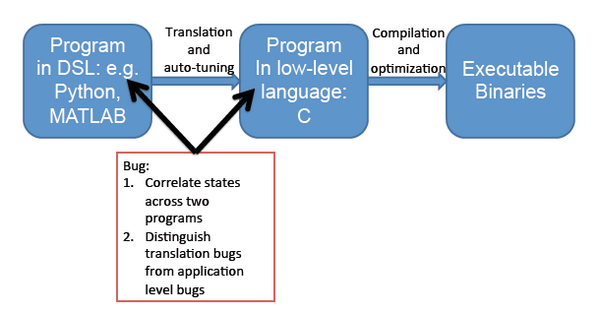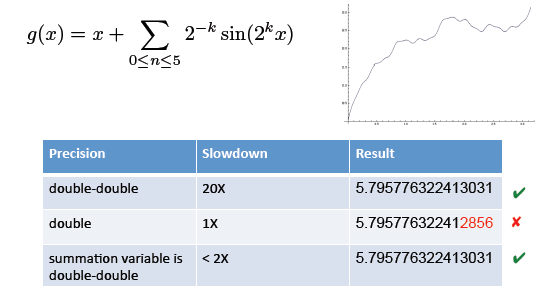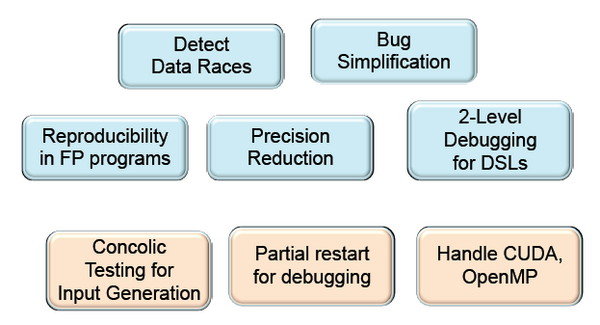CORVETTE
From Modelado Foundation
| CORVETTE | |
|---|---|
 | |
| Team Members | UC Berkeley, LBNL |
| PI | Koushik Sen (UC Berkeley) |
| Co-PIs | James W. Demmel (UC Berkeley), Costin Iancu (LBNL) |
| Website | team website |
| Download | {{{download}}} |
Program Correctness, Verification, and Testing for Exascale or CORVETTE
Team Members
Motivation
- High performance scientific computing
- Exascale: O(106) nodes, O(103) cores per node
- Requires asynchrony and “relaxed” memory consistency
- Shared memory with dynamic task parallelism
- Languages allow remote memory modification
- Correctness challenges
- Non-deterministic causes hard to diagnose correctness and performance bugs
- Data races, atomicity violations, deadlocks …
- Bugs in DSL
- Scientific applications use floating-points: non-determinism leads to non-reproducible results
- Numerical exceptions can cause rare but critical bugs that are hard for non-experts to detect and fix
- Non-deterministic causes hard to diagnose correctness and performance bugs
Goals
Develop correctness tools for different programming models: PGAS, MPI, dynamic parallelism
I. Testing and Verification
- Identify sources of non-determinism in executions
- Data races, atomicity violations, non‐reproducible floating point results
- Explore state-of-the-art techniques that use dynamic analysis
- Develop precise and scalable tools: < 2X overhead
II. Debugging
- Use minimal amount of concurrency to reproduce bug
- Support two-level debugging of high-level abstractions
- Detect causes of floating-point anomalies and determine the minimum precision needed to fix them
Testing and Verification Tools
Scalable Testing of Parallel Programs
- Concurrent Programming is hard
- Bugs happen non‐deterministically
- Data races, deadlocks, atomicity violations, etc.
- Goals: build a tool to test and debug concurrent and parallel programs
- Efficient: reduce overhead from 10x‐100x to 2x
- Precise
- Reproducible
- Scalable
- Active random testing
Active Testing
- Phase 1: Static or dynamic analysis to find potential concurrency bug patterns, such as data races, deadlocks, atomicity violations
- Data races: Eraser or lockset based [PLDI’08]
- Atomicity violations: cycle in transactions and happens‐before relation [FSE’08]
- Deadlocks: cycle in resource acquisition graph [PLDI’09]
- Publicly available tool for Java/Pthreads/UPC [CAV’09]
- Memory model bugs: cycle in happens‐before graph [ISSTA’11]
- For UPC programs running on thousands of cores [SC’11]
- Phase 2: “Direct” testing (or model checking) based on the bug patterns obtained from phase 1
- Confirm bugs
Goals
- Goal 1. Nice to have a trace exhibiting the data race
- Goal 2. Nice to have a trace exhibiting the assertion failure
- Goal 3. Nice to have a trace with fewer threads
- Goal 4. Nice to have a trace with fewer context switches
Challenges for Exascale
- Java and pthreads programs
- Synchronization with locks and condition variables
- Single node
- Exascale has different programming models
- Large scale
- Bulk communication
- Collective operations with data movement
- Memory consistency
- Distributed shared memory
- Cannot use centralized dynamic analyses
- Cannot instrument and track every statement
Further Challenges
- Targeted a simple programming paradigm
- Threads and shared memory
- Similar techniques are available for MPI and CUDA
- ISP, DAMPI, MARMOT, Umpire, MessageChecker
- TASS uses symbolic execu7on
- PUG for CUDA
- Analyze programs that mix different paradigms
- OpenMP, MPI, Shared Distributed Memory
- Need to correlate non‐determinism across paradigms
How Well Does it Scale?

- Maximum 8% slowdown at 8K cores
- Franklin Cray XT4 Supercomputer at NERSC
- Quad‐core 2.x3GHz CPU and 8GB RAM per node
- Portals interconnect
- Optimizations for scalability
- Efficient Data Structures
- Minimize Communication
- Sampling with Exponential Backoff
Debugging Tools
Debugging Project I
- Detect bug with fewer threads and fewer context switches
Experience with C/PThreads: Over 90% of simplified traces were within 2 context switches of optimal
Small model hypothesis for parallel programs
- Most bugs can be found with few threads
- 2‐3 threads
- No need to run on thousands of nodes
- Most bugs can be found with fewer context switches [Musuvathi and Qadeer, PLDI 07]
- Helps in sequential debugging
Debugging Project II
- Two‐level debugging of DSLs
- Correlate program state across program versions
Debugging Project III
- Find floating point anomalies
- Recommend safe reduction of precision
Floating Point Debugging
Why do we care?
- Usage of floating point programs has been growing rapidly
- HPC
- Cloud, games, graphics, finance, speech, signal processing
- Most programmers are not expert in floating‐point!
- Why not use highest precision everywhere
- High precision wastes
- Energy
- Time
- Storage
Floating Point Debugging Problem 1: Reduce unnecessary precision
- Consider the problem of finding the arc length of the function
How can we find a minimal set of code fragments whose precision must be high?
Floating Point Debugging Problem 2: Detect Inaccuracy and Anomaly
What can we do?
- We can reduce precision “safely”
- reduce power, improve performance, get better answer
- Automated testing and debugging techniques
- To recommend “precision reduction”
- Formal proof of “safety” can be replaced by Concolic testing
- Approach: automate previously hand-made debugging
- Concolic testing
- Delta debugging [Zeller et al.]
Implementation
- Prototype implementation for C programs
- Uses CIL compiler framework
- http://perso.univ-perp.fr/guillaume.revy/index.php?page=debugging
- Future plans
- Build on top of LLVM compiler framework
Potential Collaboration
- Dynamic analyses to find bugs ‐ dynamic parallelism, unstructured parallelism, shared memory
- DEGAS, XPRESS, Traleika Glacier
- Floating point debugging
- Co‐design centers
- 2‐level debugging
- D-TEC
Summary
- Build testing tools
- Close to what programmers use
- Hide formal methods and program analysis under testing
- If you are not obsessed with formal correctness
- Testing and debugging can help you solve these problems with high confidence





